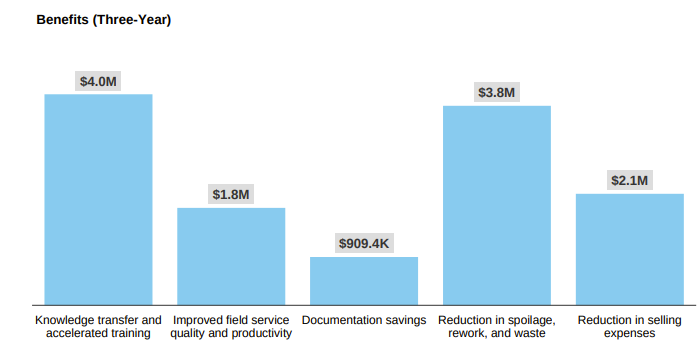Augmented reality is a touted potential benefit of edge computing. In fact, many enterprises had been using AR since at least 2018 for training applications. That suggests we could see many more such use cases in broader settings.
But AR also is easier for some use cases when IoT sensing also is available and edge computing also is available, showing the interplay of a complex of new technologies enabling value from IoT, edge computing, artificial intelligence and 5G (private and public), all interworking.
That might be true for organizations in industrial settings conducting remote diagnostics and adjustment. One study by Forrester Research of PTC’s “Vuforia” industrial AR system found return on investment in the form of 50-percent-reduced training time; 60-percent-faster document creation time and a reduction in overtime payments between 10 percent and 12 percent.
The usual caveats apply. It is not clear that any one innovation drives organization results by itself. We cannot tell whether firms that are "best in class" are better at most things, or whether a particular innovation produces the results change.
In other words, maybe "best" firms adopt new technologies more effectively, rather than new technologies producing better outcomes by themselves.

source: Forrester Research
Also, industrial AR often relies on a complex of new technologies, all introduced together: 5G, AI, AR and edge computing, for example. Observed results might be produced only when all are used together, and are gainfully producing measurable results in business operations.
In other words, IoT allows real-time or near-real-time data collection. Whether that is translated into dynamic process reconfiguration or integrated into other business functions is another issue.
As early as 2018, surveys of enterprises made by Aberdeen Group had found 72 percent of “best-in-class” organizations already use internet of things sensors and systems to capture and share diagnostics data with off-site stakeholders.
Specifically, 67 percent of users of augmented reality technology use IoT specifically as a means to conduct remote repairs.
Those firms also used augmented reality. Researchers at Aberdeen Group found that AR-powered knowledge sharing is being employed by 25 percent of “best-in-class” firms.
AR-powered on-site guides were used by 31 percent of best-in-class organizations. Eventually, one might hope, AR will be used not only to train but to aid technicians in the process of making repairs, for example, especially remote repairs.

source: Aberdeen Group, PTC
Aberdeen argues that AR is a tool to improve the quality and consistency of customer support, as well as reduce service technician turnover.
On average, organizations are seeing technician turnover of 31.5 percent, Aberdeen Group has found. To add to this problem, an increasing number of service technicians are contracted (an average of 26.4 percent), meaning less consistency in service delivery, and more short-term labor that needs to be quickly on-boarded and trained.
Organizations with higher-than-average turnover see a 14 percent lower first-time fix rate compared to firms with lower turnover (52 percent compared to 66 percent).
High-turnover companies also see customer Organizations with higher-than-average turnover see a 14 percent lower first-time fix rate compared to firms with lower turnover. v3 3 retention at a mere 60 percent, compared to 72 percent for those with lower than-average turnover, Aberdeen Group researchers say.